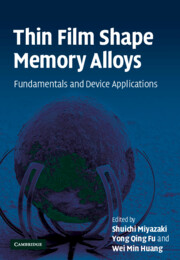Book contents
- Frontmatter
- Contents
- List of contributors
- Preface
- Abstracts of chapters
- 1 Overview of sputter-deposited TiNi based thin films
- 2 Martensitic transformation in TiNi alloys
- 3 Deposition techniques for TiNi thin film
- 4 TiNi multilayer thin films
- 5 Crystallization and microstructural development
- 6 Mechanical properties of TiNi thin films
- 7 Stress and surface morphology evolution
- 8 Ion implantation processing and associated irradiation effects
- 9 Laser post-annealing and theory
- 10 Overview of thin film shape memory alloy applications
- 11 Theory of SMA thin films for microactuators and micropumps
- 12 Binary and ternary alloy film diaphragm microactuators
- 13 TiNi thin film devices
- 14 Shape memory microvalves
- 15 Superelastic thin films and applications for medical devices
- 16 Fabrication and characterization of sputter-deposited TiNi superelastic microtubes
- 17 Thin film shape memory microcage for biological applications
- 18 Shape memory thin film composite microactuators
- 19 TiNi thin film shape memory alloys for optical sensing applications
- Index
13 - TiNi thin film devices
Published online by Cambridge University Press: 23 February 2010
- Frontmatter
- Contents
- List of contributors
- Preface
- Abstracts of chapters
- 1 Overview of sputter-deposited TiNi based thin films
- 2 Martensitic transformation in TiNi alloys
- 3 Deposition techniques for TiNi thin film
- 4 TiNi multilayer thin films
- 5 Crystallization and microstructural development
- 6 Mechanical properties of TiNi thin films
- 7 Stress and surface morphology evolution
- 8 Ion implantation processing and associated irradiation effects
- 9 Laser post-annealing and theory
- 10 Overview of thin film shape memory alloy applications
- 11 Theory of SMA thin films for microactuators and micropumps
- 12 Binary and ternary alloy film diaphragm microactuators
- 13 TiNi thin film devices
- 14 Shape memory microvalves
- 15 Superelastic thin films and applications for medical devices
- 16 Fabrication and characterization of sputter-deposited TiNi superelastic microtubes
- 17 Thin film shape memory microcage for biological applications
- 18 Shape memory thin film composite microactuators
- 19 TiNi thin film shape memory alloys for optical sensing applications
- Index
Summary
Abstract
This chapter provides a brief review of TiNi thin film devices, both mechanical and biomedical, that have been studied during the last decade. Prior to reviewing devices, we first provide a description of physical features critical in these devices, including deposition, residual stresses and fabrication. In general, this chapter concludes that the main obstacle for implementing devices today remains control of TiNi properties during manufacturing. If this can be overcome, the next issue is to develop acceptablemicro machining techniques. While several techniques have been studied, considerable work remains on fully developing processes that would be required in mass manufacturing processes. Finally, if these issues can be resolved, the area with the most promise is biomedical devices, the argument here is that biomedicine remains one of the major applications areas for macroscopic TiNi structures today.
Introduction
Shape memory alloys (SMAs) have fascinated researchers for the last few decades in a range of “macroscopic” industrial and medical applications due to their intrinsic properties such as large stress output, recoverable strain, excellent damping and biocompatibility. More recently the research community has begun to investigate research opportunities in the microscale with the use of thin film SMAs integrated into microdevices [1, 2, 3, 4, 5]. SMAs (e.g. TiNi) exhibit a thermally induced crystalline transformation between the martensitic phase, a low temperature phase, and the austenitic phase, a high temperatures phase. Upon cooling below the martensitic finish (Mf) temperature, undeformed SMAs have a twinned martensitic structure. Under a relatively low applied stress, the twinned martensitic structure is rearranged along the stress direction and produces deformation.
- Type
- Chapter
- Information
- Thin Film Shape Memory AlloysFundamentals and Device Applications, pp. 321 - 345Publisher: Cambridge University PressPrint publication year: 2009

